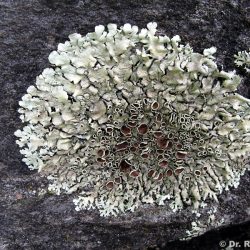On the lava flows of the most recent eruptive events of Vesuvius (1906, 1929, 1944) numerous pioneer species (mosses, lichens…) have settled. Among these, the lichen Stereocaulon vesuvianum prevails.

Therefore, in these environments, the adhesion of the lichen thallus to the surface of the rock and the penetration of hyphae play a role both in preserving the finest sediments from the erosive action of wind, rain and run-off water on the rocky surface, and in pioneering physical disintegration of the rock. Instead, the accumulation of aluminium around the hyphae of Stereocaulon, the production of calcium oxalates and the enrichment in iron at the rock/lichen interface highlight the interaction of the lichen with the underlying rocks and their action in the chemical alteration of the rocks. The combination of these physical and chemical processes slowly leads to the genesis of the soil.
Stereocaulon vesuvianum is a fruticose thallus species (similar to tufts). The thallus is the vegetative body of the lichen and is formed by fungal hyphae (filaments) and algae. The part of the thallus with pseudopodices (circular section, granular branches) is mainly visible, as it is covered by abundant filloclades (scales of various shapes) of whitish, ash-grey colour.

The Stereocaulon hyphae penetrate into the cracks of the volcanic rock and begin to physically disintegrate the rock.
Around the Stereocaulon hyphae there is an accumulation of iron and aluminium in the form of oxides and minerals that are not very crystalline.
The Xanthoparmelia conspersa (Ehrh.) Ach. is another lichen, but with a foliose thallus (similar to foliar laminae), which colonizes the Vesuvian rocks.

Calcium oxalates are present in the thallus and in the sediments at the lichen/rock interface. Oxalates are produced by the interaction between oxalic acid and rock minerals.
Enrichment in iron, in the sediments present between the rock and the lichen. The white areas consist of calcium oxalates.




